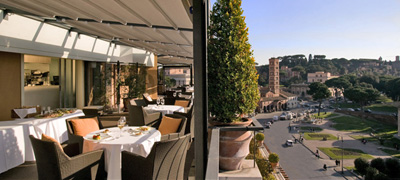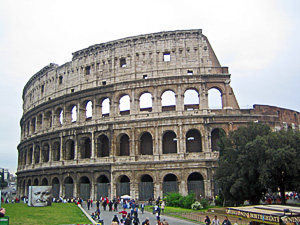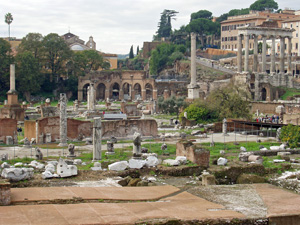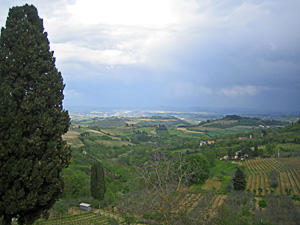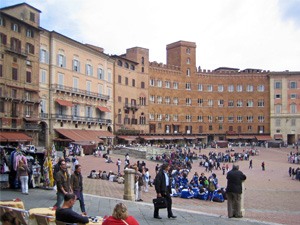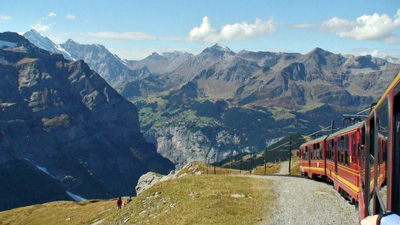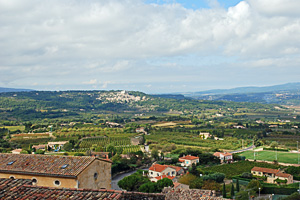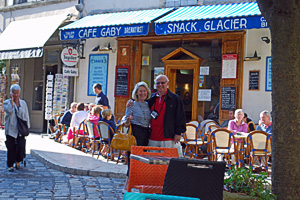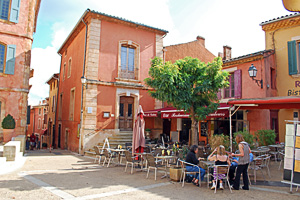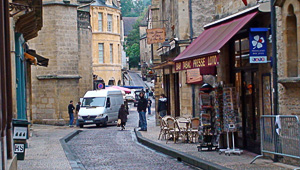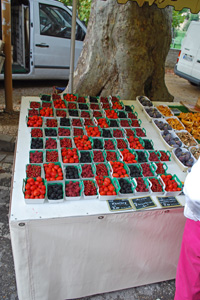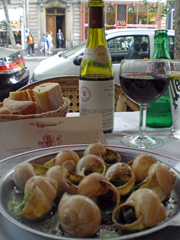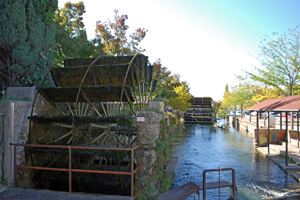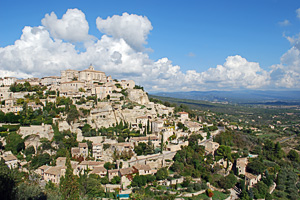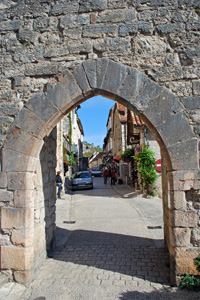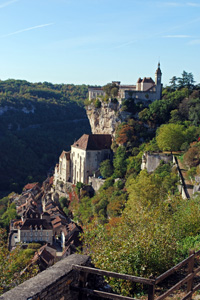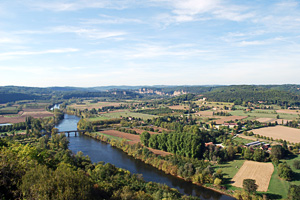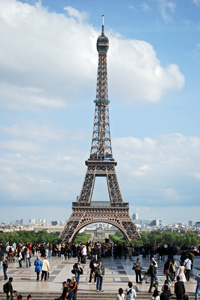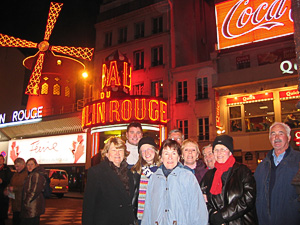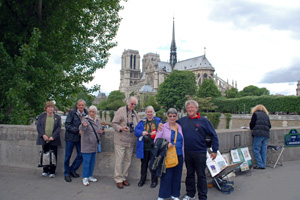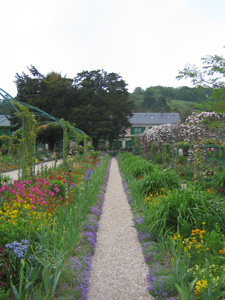Off the Beaten Track: Europe's Provincial Diversions
A day-by-day recounting of this 2009 European rail tour from Rome to Paris via the Market Towns & Hill Villages of Tuscany, the Swiss Lakes & the South of France.
JETTING OFF
Sunday
We joined our flight at Brisbane International Airport today, with 6 tour members from Brisbane. While Pauline was her fourth tour with us, for two others it was their first trip overseas: they were excited finally to be setting off on their holiday of a lifetime, enjoying the train tours of Europe.
They have been looking forward to this for so long, they said, because travelling around Europe by train on the 1970s baby boomer special - backpacking, youth hostelling and the trusty Eurailpass - is something they had missed out on as students.
They have promised to make up for it now! They are doing a Europe river cruise after our train tour of Europe.
The Qantas flight to Hong Kong was excellent. Here we met another 7 people from Melbourne and Sydney, (including Marie who has done two train tours of Europe with us before this one). We flew on together on our Cathay Pacific flight to Rome [Qantas flight numbers, and frequent flyer points!].
ROME
Monday
Buongiorno Europa. Buongiorno Roma. We arrived at Rome's Fiumicino Airport also called Leonardo da Vinci Airport, at 6am (yawn!). There were 4 other people due to arrive on the Thai flight 15 minutes later, so I took out the trusty “Great Trains of Europe Tours” sign and waited at the exit from Customs while the others had their first Italian cappuccino in the Arrivals Hall. We could have started our holiday by rail through Europe, literally, right away by taking the Leonardo Express from the airport to the Stazione Termini (Central Station) but with the luggage, it made more sense to have arranged a bus transfer to our city-centre hotel.
The Rome hotel that we use for all of our company's rail tours of Europe, the Hotel Forty Seven, is in the heart of Classical Rome - a walk from the Forum and Coliseum. We are always welcomed as old friends here.
Tour members had been given the option of paying for the hotel the night before to guarantee that the rooms would be ready as soon as we arrived at 7am. Last night's guests don't have to check out until 12noon, so rooms can't be guaranteed until 2pm. Most decided against the extra cost because they were keen to hit the ground running. How surprised and delighted they were to find that the rooms were ready when we arrived. [This is a rare occurrence indeed].
A quick shower and, “Rome. here we come”. We will be seeing Europe by train; but in Rome the bus is best. Several major bus routes pass right by our hotel door. I took those interested in getting started to the TABAC (tobacconist) shop - right out of the hotel and about 200 metres, then cross over - and helped them buy an all-day pass for 6 Euros (about $10) valid on all the buses and the Underground train system.
The underground system has only two lines: every underground excavation in Rome is an archaeological dig! In any case, from the bus we can see the wonders of this historic city. So, no rail travel within Europe's ancient capital!
Today is listed in the itinerary as a rest day to recover from the flight and no sightseeing programme was arranged: I planned to spend the day meeting later flights (British Airways mid-morning and Emirates in the early afternoon) to bring the other tour members into Rome.
Tomorrow and the day after we will have group visits to the major sights of Classical and Catholic Rome. Two couples were keen to see a few lesser known Christian (Catholic) shrines in Rome, and several others decided to join them rather than wait around the hotel.
I suggested and gave directions to the Jesuit Church near the Pantheon (world headquarters of the Jesuit Order - stunning ceiling painting, up there with Michelangelo) and, only a few metres away, the Church of the French Embassy with Caravaggio originals adorning the side chapels. They planned also to go out to the Catacombs of San Sebastian in the afternoon and see the shrine to St Cecilia, the Patron Saint of Music, but jetlag kicked in and they went back to the hotel for a nap.
We met the rest of the group for drinks at 7pm, and then headed out for a meal together in a restaurant nearby. Restaurants generally don't open for dinner in Rome until 8pm. A trap for young players in Italian restaurants: pasta is the first course; don't fill up on too much spaghetti because there is a meat course to come.
After dinner we undertook the traditional Italian after dinner stroll [passagietta] in the cool of the evening - part aid to digestion, mostly fashion statement. Awake at 3am. Hello, jetlag!
ROME
Tuesday Top
Our organised sightseeing today focused on Classical Rome. Leaving the hotel at 9.30am we visited the nearby Coliseum. Stunning! The Coliseum's real name is the Amphitheatre Flavia, an amphitheatre built by Emperor Flavius in the first century AD. It was built to seat 50,000 spectators. Here gladiator sports were popular and, on occasion, prisoners of war were forced to fight with lions.
The legends of Christians being fed to the lions here are just that - legends. The first recorded mention of the site of the Coliseum having any Christian significance is as recent as the thirteenth century. It seems certain that it was at the bottom end of the Circus Maximus (between the hotel and the Coliseum) that this punishment was meted out by the Romans to members of the outlawed Christian sect.
Its legendary crumbled look is due to the fact that for centuries in Christian Rome (post 380AD) it was a quarry providing marble for other buildings, principally churches. Tradition has it that Napoleon declared it to be 'colossal', and that it has been called the Coliseum ever since. Another tradition (enjoying the weight of scholarly opinion) is that one of the wonders of the classical world, the colossus of Nero (a huge statue) stood on this site.
It is not far to the Pantheon, the only Classical Roman building still standing completely intact. When St Paul came to Rome in the 60s AD it was standing, much as it is today.
Originally a Pagan temple to “all the gods”, hence Pan-theon, it has been a Christian Church for some centuries. Here are the tombs of the Italian kings from before the time of the Italian Republic. The artist Raphael's tomb is also here. On the way to the Pantheon we pass the spot where the Senate stood. This is where Julius Caesar was assassinated.
Sightseeing over, most of the group stayed together for lunch in Piazza Navona - many open air restaurants to choose from, and Bernini's fountains to watch while tucking into the pasta.
A few of our number headed back to the hotel for siesta: a noble Italian tradition. Others joined me a short walk to a few “must sees” that are, strictly speaking, part of neither Classical Rome nor Catholic Rome - the Spanish Steps and the Trevi Fountain. The afternoon was rounded out by my taking those still keen for more action to the fashion shopping streets.
ROME
Wednesday
Our sightseeing today focussed on Catholic Rome.
We met in the hotel foyer at 9.30am, with our Bus/Metro tickets already purchased from the TABAC. We took the bus from outside the hotel to the Vatican State, home of St Peter's basilica, the Mother Church of World Catholicism. Firstly, we strolled through St Peter's Square, an architectural masterpiece in its own right, begun by Bernini in 1656. At the centre of St Peter's Square stands a First Century BC obelisk brought to Rome from Egypt in 37 AD by order of Emperor Caligula. The basilica of St. Peter is said to be built on the site of the tomb of St Peter, the disciple of Jesus who made his way to Rome and who, says the legend, became the bishop of Rome before being crucified here, upside down, in 64 AD.
There were certainly Christians in Rome by 48 AD and from that time until 313 AD Christianity was an outlawed and frequently persecuted sect in the Roman Empire. In 313 AD the Roman Emperor Constantine converted to Christianity and permitted Christian worship within the Empire. In the 380s AD Emperor Theodosius imposed Christianity as the official religion of the Roman Empire. Now one was persecuted for not being a Christian. With Christianity now the official religion of the Roman Empire, the Christian bishop in Rome took over the role formerly occupied in Imperial civic life by the Chief Priest of Paganism, the now discredited Roman Imperial religion. Within the Christian churches scattered throughout the Mediterranean and European world, therefore, the bishop in Rome gradually came to occupy a position of greater authority among the bishops of the universal (catholic) Christian Church. Only in the ninth century did the bishop of Rome, the Pope (equals Italian “papa”, father) come to occupy the position of authority he exercises today over the whole Roman Catholic Church.
In the late 15th century the popes decided to pull down the old St Peter's Church and build a new one. Bramante, Michelangelo and Bernini all contributed to the construction of St Peter's Basilica, the world's largest church. Inside, there are markers on the floor to show how much shorter than St. Peter's are the other great churches of the world.
On the right hand side on entering the Church, stands see Michelangelo's Pieta - one of his four Pietas, in fact. It is now behind bullet-proof glass, since it was attacked by an Australian (a Hungarian migrant) with a hammer in the 1970's.
I tried to forget that German peasants starved (on sufferance of Hell) to provide the money for these places. They are truly magnificent. The Renaissance Popes may have been a decadent lot, but they were the greatest patrons of the arts ever known in Western civilisation.
There was a request for a stroll among the tombs of the popes of all the centuries. Their vaults are beneath the floor of St Peter's, and we walked among them. We saw that the tomb of the greatly loved John XXIII, was decked with fresh flowers. He was Pope for only 5 years in the 1960s. It was he who called the Second Vatican Council and put the Roman Catholic Church on the road to reform. Some traditionalist Catholics think that the rot set in as a result of his work. The tomb of John Paul II had weeping Spanish and South American pilgrims mounting a prayer vigil.
Meeting again at the pre-arranged spot in the square, we took a late morning coffee. A few were succumbing to hunger pains and made it an early lunch.
Then the piece de resistance - the Sistine Chapel. In the summertime the crowds here can be stifling and the queues hours long. Everybody arrives early to avoid the crowds, thereby creating the even bigger crowds. Experience dictates that at lunch time, when Rome is on siesta, and other tour groups at lunch, the queues are shortest. This is why we arranged our group entrance at 1pm.
Our visit to the Vatican Museums was covered in about 90 minutes, zooming through the early long corridors. This might have seemed like sacrilege to some, but you could easily spend a year here. These galleries certainly looked impressive but we sped through them because they are as nothing compared with what lay ahead. We lingered as we approached the Raphael Rooms, before the Sistine Chapel.
Here the milling crowds, seemed vaguely distracted, gazing about with puzzled faces as if to ask 'are we there yet'? 'There' is the Sistine Chapel. We had a few moments to enjoy the Raphael Rooms. Raphael's “School of Athens” is one of my favourites. Then we made our way down narrow stairs with warnings everywhere to be silent and not to photograph. It is obvious that the English and Japanese speakers are the most talkative: the repeated PA messages from the Inquisition to be quiet were in these two languages.
We stepped into the Sistine Chapel and looked up. I had been here many times before, but I always enjoy watching the faces of my tour members, as they look up - especially if they have never seen it in real life before. Words fail when one tries to describe the enormous and stunning ceiling painted by Michelangelo between 1508 and 1512.
Pope Sixtus IV (hence Sistine) converted this room into a chapel and commissioned Michelangelo to paint the ceiling and the back wall behind the High Altar. The Creation stories on the ceiling and the Last Judgement behind the altar are perhaps best known.
We assembled on the raised section at the exit door on the left past the partition through the middle of the chapel. Groups are permitted only 20 minutes in the chapel. We emerged from the Vatican Museums and had a stop for coffee to regain our stamina and our breath (the Sistine Chapel can take the breath away). Depending on the state of body-clock re-adjustment from the jetlag, this was a late lunch (old Italian tradition) or an early afternoon coffee.
Pleading fatigue, most of the group went back to the hotel for siesta. I assisted three couples to make a visit to the Christian Catacombs just outside Rome - on their day bus tickets, thereby saving the standard 50Euros of the commercially operated tours.
Directions to the Catacombs: Take Bus # 118 from the Arch of Titus near our hotel, down the Appian Way to the Catacombs of San Sebastian, about 20 minutes away. You know St Sebastian from Christian art. He always has lots of arrows protruding from him. You've guessed how he was martyred.
To SAN GIMIGNANO, Tuscany
Thursday Top
I asked the group to have their luggage outside their doors by 8am to be collected and taken on ahead to San Gimignano. When I ask groups for feedback about tours, to assist in improving service on future tours, the luggage handling is always close to the top of the list of the good things about the tour.
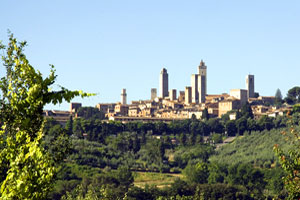
San Gimignano atop a hill in Tuscany
Many people hate the regimented life of European coach tours, and the relentless pushing on each day “If this is Tuesday, it must be Belgium!” But their efforts at taking themselves around Europe by train are overwhelmed by the loading and unloading bags in railway stations.
Leonardo, my little “man with a van” whisks our luggage away - as he has done for years - and we know that when we arrive in our new hotel tonight, it will be there.
We were ready to leave at 8.15am and jumped the bus to the Stazioni Termini where we were all excited to commence our rail tour through Europe. The first leg of our train tour through Europe was on one of the great trains of Europe, the 280 kilometre an hour Eurostar Italia High Speed train to Florence (Firenze to the Italians), the cradle of our Western civilisation and the birthplace of the Renaissance.
I had to remind the gang that they would have plenty of time to enjoy Florence's artistic treasures in a few days' time; and that today we were merely in transit. I had a sneaking suspicion that the leather shops might have been equally magnetic as the museums for some of our number. This is a non-sexist remark!
Florence's Central Railway Station is called Firenze Santa Maria Novella, the name of the church adjacent to the tracks. It was the first Renaissance Church in Florence; make that the first Renaissance Church in the world.
In this very busy station, we changed to a local train for a slower pace. We trundled through the Vale of Chianti - vineyards, olive groves, stone farm houses and church towers peering through the mist - to Poggibonsi. This is one of my favourite rail journeys of Europe. In Poggibonsi we hopped off and met Leonardo who took us up the hill to San Gimignano. The village, with its trademark thirteen mediaeval towers, is largely unchanged from the thirteenth century. There were originally over a hundred such towers. The village is walled and our hotel, home for four nights, is inside the walls.
San Gimignano rises on a hill (334m high) dominating the Elsa Valley with its towers. Once the seat of a small Etruscan village of the Hellenistic period (200-300 BC) it began its life as a town in the 10th century taking its name from the Bishop of Modena, St. Gimignano, who is said to have saved the village from the barbarian hordes. The town increased in wealth and developed greatly during the Middle Ages thanks to the “Via Francigena” the trading and pilgrim's route that crossed it. Such prosperity led to the flourishing of works of art to adorn the churches and monasteries. In 1199 it became a free municipality and fought against the Bishops of Volterra and the surrounding municipalities.
Due to internal power struggles it eventually divided into two factions one headed by the Ardinghelli family (Guelphs) and the other by the Salvucci family (Ghibellines). On the 8th May 1300 Dante Alighieri came to San Gimignano as the Ambassador of the Guelph League in Tuscany.
In 1348 San Gimignano's population was drastically reduced by the Black Death Plague throwing the city into a serious crisis which eventually led to its submission to Florence in 1353. In the following centuries San Gimignano overcame its decline and isolation when its beauty and cultural importance together with its agricultural heritage were rediscovered. The construction of the towers dates back to the 11th and 13th centuries. The architecture of the city was influenced by Pisa, Siena and Florence. There are 14th century paintings of the Sienese School to be seen, and 15th century paintings of the Florentine School.
The village is completely walled and no traffic is permitted in between 9am and 6pm. The walk was not too strenuous from the gate to our hotel - a couple of hundred metres. Our hotel, the Antico Pozzo, is on the main thoroughfare between the St Matthew's Gate and the central piazza.
The afternoon was free for a leisurely Italian (ie. late) lunch at an outdoor café with views across the Tuscan countryside, to check out the shops or to stroll aimlessly through the narrow cobblestone streets and alleyways of this beautiful mediaeval village.
SAN GIMIGNANO, Tuscany
Friday
I had explained to the tour group members that each day while we are “Off the Beaten Path”, an excursion is offered. These excursions are included in the tour cost and are on a bus chartered for our exclusive use. Tour members had the option of joining the excursion or simply have a lazy day pottering about our “home” village. As it happened, every member of the group took today's excursion.
We met in the hotel foyer at 9am and strolled down to the gate to join our chartered bus - Leonardo at the wheel - for the drive through some of Tuscany's most beautiful countryside to the walled hill village of Montepulciano. Today's excursion included the two villages which produce Tuscany's - no, Italy's - greatest red wines. Debate rages over whether the Vino Nobile di Montepulciano or the Brunello di Montalcino is Italy's great red. Judging by the number of people sleeping in the bus on the way home this afternoon, I suspect that some serious research was undertaken!
Montepulciano is a walled market town which sprawls down the side of a hill. It has 14,000 inhabitants and a long winding main street, called the Corso, which winds from the Town Hall and Cathedral Square at the top down to the bus station at the bottom. As an added bonus, today was Market Day in Montepulciano.
According to a Renaissance legend, it was founded in 509 BC by Porsenna, the Etruscan Lucomone of Chiusi, following the expulsion of Tarquinius the Proud from Rome. Though that cannot be proven, the Bishops of Siena and Arezzo did meet before the Steward of King Liutprando in about 700 AD, and argued bitterly for suzerainty of Montepulciano. The Bishop of Arezzo won, perhaps sowing the seeds for the long-standing antagonism between Siena and Montepulciano that helped make the town one of Florence's staunchest allies.
It was the home of the humanist scholar Poliziani, who was tutor to the sons of Lorenzo the Magnificent of Florence, one of whom became Pope Leo X with whom Luther did battle.
About halfway down the Corso on the right hand side stands an olde world coffee shop with fabulous furnishings, sweeping views and pretty good coffee, as judged by our resident coffee experts. As in San Gimignano, so in Montepulciano, the restaurants right at the top of the town offered sweeping views over the Tuscan countryside.
We rejoined our bus at the bus park at the bottom of the hill at 2pm for the short ride through more picturesque Tuscan countryside to the arch-rival village of Montalcino. Much, much smaller - just one street really - but in my humble opinion, home of the superior wine.
A stroll, some wine tasting or coffee, and we rejoined our bus at 5pm for the drive “home” to our San Gimgnano hotel.
How pleasant San Gimignano is after the tour buses have taken away the day visitors. Dinner menu prices are lower than at lunchtime, when only the locals - we - are here. Already, on only our second day here we are beginning to feel like locals as the various shopkeepers and restaurant owners recognize us as we walk by. Buona sera [good evening] - a useful phrase.
SAN GIMIGNANO, Tuscany
Saturday Top
Today's excursion was to Siena, rival of Florence through the early Renaissance and one of Italy's lesser known artistic gems.
Within the hour we arrived in Siena, a perfectly preserved 13th century city, just as San Gimignano is a perfectly preserved 12th century hill village. But they are not museums; they are vibrant 21st century communities.
Something a little macabre started our visit to Siena. The Church of San Domenico - which we passed on the stroll from the bus park - displays the preserved, severed head of St Catherine of Siena.
We peeked in on the historic Campo (the undulating city square where the bare back horse race the Palio is run in the summer) on our way up, up, up, to the black and white cathedral whose extension was halted in 1348 when the Black Death struck. It was never finished.
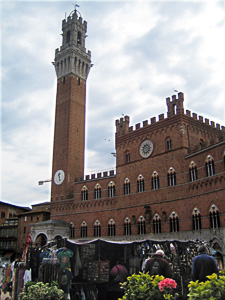
The Town Hall in Siena
It starred in the film “My House in Umbria”. It is where Ronnie Corbett and Maggie Smith lose the little girl. Who's the British movie junkie, then?
The afternoon was free to explore the shops and passageways which gravitate back to the Campo Square. Restaurants abound on the Campo and in the streets leading away from it. Personally speaking I enjoy sitting at an open air café on the Campo, watching the crowds and trying to identify nationalities by their appearance and mannerisms before I hear their voices and accents.
Our rendezvous point was on the steps leading into the Campo at 2.30pm where we made our way back to the bus for our return to “our” village, San Gimignano.
But I kept a wee surprise for the way home. We dropped in ever so briefly at the village - more a hamlet, actually - of Monteriggioni. Its fortifications are truly unique. The circular wall is completely intact, and from the battlements one can enjoy a sweeping view across the Tuscan countryside to our “home” village of San Gimignano with its thirteen towers silhouetted against the afternoon sky.
Another night in San Gimignano. More fabulous “slow” food. I renewed my acquaintance with Taverna Paradiso: I have been eating here for years and the food is always good and very reasonably priced.
SAN GIMIGNANO, Tuscany
Sunday
A day very much ON the Beaten Track today, but we can't be so close without visiting Florence, the birthplace of Western civilisation. There was mass in the cathedral next door from 6am; - the bells started well before then. Couldn't find a Protestant Church - this is Italy.
Leonardo zoomed us down the hill in his bus to the Poggibonsi Station for our slow, winding, route through the Vale of Chianti again to Florence.
Our introductory sightseeing tour today was on foot, because the city is so compact; the afternoon would be free for the shops or people watching from a sidewalk café, however, one museum entrance must be considered compulsory - to see Michelangelo's “David”. Some say that this visit alone justifies the cost of the airfare to Europe.

Michelangelo's David
The Galleria della Accademia is a small gallery whose highlights include Michelangelo's “Il Prigioni” - the Prisoners. Are they incomplete or did Michelangelo leave them like this deliberately, still trapped in stone, to show the futility of the struggle to be free from time and the cares of humanity? Art critics are divided. Isn't the latter the better explanation? But what we really came to see is Michelangelo's “David” - marble, 14 feet and magnificent. You'll see a few copies standing around Florence covered with messages from generations of pigeons, but there can be no substitute for the original.
Meeting at the Museum exit at a pre-arranged time, we headed for the Baptistery and the Cathedral with its dome by Brunelleschi and its bell tower by Giotto. Both could be explored later at leisure; now we paused for a quick art history lesson on the steps of the cathedral, with an elevated view of Ghiberti's celebrated “Gates of Paradise” bronze doors on the Baptistery.
Another short walk brought us to the Piazza della Signoria, the city square of Mediaeval and Renaissance Florence, and the nearby Ponte Vecchio, Florence's 12th century bridge lined with silver shops. Did you enjoy the movies “Tea with Mussolini” or “Room with a View”? If so, this is your town. The Ponte Vecchio is only 100 metres from the Uffizi Galleries which have possibly the best collection of Renaissance paintings anywhere on earth. The entrance is near the fake David in the square. Entrance costs 15 Euros. It would be a bargain at 150Euros.
I find it impossible to conduct a guided tour of an art gallery because of widely differing interests of the group members. But I gave a few “must see” hints, and eight of our number forsook the leather shops to “warm both hands at the fires of Michelangelo and Botticelli” as Dame Judi Dench famously declares in Tea with Mussolini.
In 1944 the retreating Nazis blew up all the bridges of Florence except the Ponte Vecchio. It is said that this was at Hitler's specific instruction. He fancied himself an artist, you will recall. The art teachers in Vienna didn't agree, unfortunately, otherwise he might have only drawn pictures of mass destruction and holocaust.
The good quality leather and shoe shops, are on to the Square in front of Santa Croce Church. This church is the Westminster Abbey of Florence, containing the tombs of all the greats of Florence - Michelangelo, Galileo, Leonardo Bruni, Macchiavelli. Now you understand why the English poets Robert and Elizabeth Barrett Browning left London to take up permanent residence here in the 1860s. People of impeccable taste.
We met on the cathedral steps at 5pm to retrace our steps “home” to San Gimignano.
To SPIEZ, Swiss Lakes
Monday
So soon it was time to farewell our beloved San Gimignano, Tuscany, and Italy. Our bags were collected at 8am to be taken on ahead to Switzerland. We met at 8.45am and strolled down to the bus park to join our charter bus to the Poggibonsi Station. Through the vineyards of the Vale of Chianti we rode our local train to Florence - one of my favourite scenic rail tours of Europe.
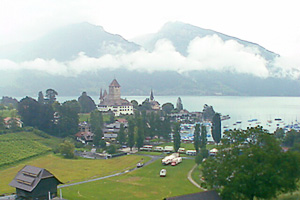
The lakeside village of Spiez
Here, in Florence, we joined the Cisalpino train, a Swiss - Italian joint venture, heading North. This has become one of the great train journeys of the world - instead of winding through the Apennines, the backbone of Italy, the rail journey now takes us via a tunnel under them, then through Bologna and across the agriculturally rich Northern Italian Plain, through Milan and past the Italian Lakes and into the Swiss Alps. The rail routes through the Swiss Alps have long been on everybody list of great rail journeys of the world. We crossed the Alps via the Simplon Tunnel, and arrived in the lakeside village of Spiez.
Our included dinner was in a waterfront restaurant, as we looked out at the boats bobbing on their moorings, with the Alps as a breath-taking backdrop. No wonder the Romantic poets went gaga over the Swiss Alps.
What a truly unique country Switzerland is: it has not joined the European common currency, the Euro, which we have been using in Italy, and shall use again in France. In Switzerland we spent Swiss francs - plenty of them at about $1.15 Australian each.
Switzerland is famous, of course, for its watches and chocolates as well as its numbered bank accounts.
Switzerland has four official languages, but there is no language called Swiss: German is spoken as the primary language by about 70% of the population in the central, northern and eastern regions of the country, including Luzern, Zurich, Bern and our village of Spiez. French is spoken by about 20% in the West, around Geneva and Lausanne, and Italian is spoken by about 10% in the South. A further 1% in the South - East around St. Moritz speak Romansch, a variant of mediaeval Latin. Yes, I know that is 101% - arithmetic was never my forte. Swiss banknotes are written in all four languages; because there is not enough space on a Swiss postage stamp for four languages, their country of origin is identified by the Latin word for Switzerland - Helvetia.
As a political entity, Switzerland dates from the twelfth century when four small cantons (shires?) around Lake Lucerne joined together. They were called the four forested cantons, and they called Lake Lucerne the lake of the four forested cantons - Vierwaldstattesee - still its name in German. The English “Grand Tour” visitors in the eighteenth century couldn't get their tongue around the German name and, in English at least, it has been called Lake Lucerne ever since. But here in Spiez we were on Lake Thun. Swiss historical disappointment #1.
The lovely story of William Tell shooting the apple off his son's head while fighting a war of liberation against the Habsburgs (more of them in Austria) is a furphy. It comes from a legend recorded in an eighteenth century novel and set to music as an opera by Rossini. Never let history get in the way of a good story.
In Spiez we were in the German speaking area of Switzerland, and the dominant cuisine is also German. Bratwurst, weisswurst, knackwurst, all manner of snags (and beer). The Wiener Schnitzel is Viennese veal, and pork is king. Did you hear about the German restaurant with a reputation for slow service? Its motto was “the wurst is yet to come”.
Those in our group who learned German at school noticed the locals speaking a very distinctive dialect of German called Switzer Deutsch - Swiss German. All bank and railway staff (and taxi drivers) must be fluent in the main three official languages of Switzerland, and most also speak English. The most basic Swiss German word which we all mastered quickly was the “Good Morning” greeting: not “Guten Morgen” as in High German, nor the “Gruss Gott” of Southern Germany and Austria but “Gruezi“.
SPIEZ, Swiss Lakes
Tuesday Top
Swiss breakfasts were a treat, especially after the Italian ones. There are many varieties of cold meats and cheeses as well as the usual European breakfast fare of pastries and croissants. Burchermuseli is a Swiss invention which we all sampled - and the hot chocolate from heaven.
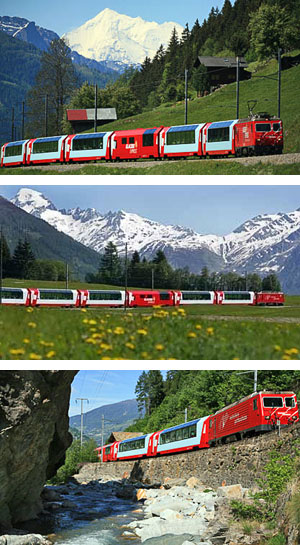
The Glacier Express amidst stunning mountain scenery
The tour brochure offered a quiet day today in the lakeside village of Spiez with an opportunity to take a paddle boat down the lake to Interlaken. A few of our number, however, had other ideas. They are serious “great train journeys of the world” junkies and knew that sitting at Number One on most people's lists of great rail journeys of the world is the Glacier Express. They knew that tomorrow would be taken up with that other contender for the top spot of the great train journeys hit parade, the Jungfrau Express. The next day we would be off to France. It was now or never for the Glacier Express!
This required an early start because we were on the other side of Switzerland from its starting point. But the train tours of Europe, especially the little Swiss Mountain Trains, are proof of the adage that the journey is as much fun as the destination. Departing at 7.30am, we joined an Intercity train, changed in Zurich, and, skirting Lake Zurich, made our way to Chur where we boarded the Glacier Express for the rail journey of a lifetime across the roof of the world. Our reserved First Class seats were in a panorama car, with half the roof made of glass to allow us to immerse ourselves in the stunning views. Our cute little red train takes us over mountain passes, past sweeping panoramas, across high bridges, and through tunnels. We chugged over the Oberalppass - a not entirely original name for an over-alp-pass - at 7,000 feet. There was even a sprinkling of early snow in the pass. We were served lunch at our seats in the panorama car.
As well, a little man wheeled his trolley of goodies through the carriages.
This section of the Glacier Express terminated in the village of Brig many photos later. Thank heavens for the delete button on digital cameras. Here we joined an InterCity train back to Spiez.
We arrived back at the hotel at 4.30pm in time for a stroll around the lake, then a sundowner on the terrace overlooking the lake as we discussed the Glacier Express' right to the accolade as the greatest train journey of the world.
One lady asked, “How do you intend topping today, Stan?” I urged them all to put off a final decision until after tomorrow's Jungfraubahn and the cute little train down the Dordogne Valley from Sarlat to Bordeaux, next week.
SPIEZ, Swiss Lakes
Wednesday
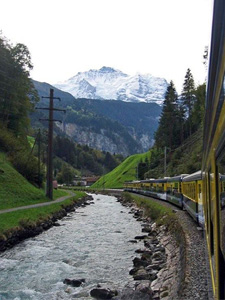
Train journey to Lauterbrunnen
There was a buzz of excitement this morning as we made our way up to the Spiez Station for our day to the highest railway station in Europe, the Jungfrau. It is early October and shirt sleeve weather down here, but up there it will be freezing. I reminded everybody to dress warmly.
Spiez is only fifteen minutes by train from Interlaken, and there we changed to a cute little green and yellow train as far as Lauterbrunnen, where we changed again to a rack railway and began seriously climbing. At Kleine Sheiddeg, at an altitude 6700 feet, at the foot of the notorious Eiger North Wall, we changed again. From here the Jungfrau Railway climbs through the Eiger Tunnel. We paused to enjoy spectacular sightseeing through large observation windows hewn from solid Alpine rock.
We arrived at the Jungfraujoch, Europe's highest railway station at a staggering 11,333 feet above sea level, in the heart of a glorious glacier world on the very roof of Europe! We were half again the height of Mt Kosciusko, and sitting in a train.
Superb views extend as far as the summits of the Vosges Mountains in France and the Black Forest in Germany. Will we ever enjoy restaurant views like these again? After our huge Swiss breakfast we opted for a light lunch, but there are two restaurant possibilities - not so cheap but very cheerful, and the other offering quite fine dining.
Back at the departure platform for the 2.30pm departure, we now wound down and down, retracing our steps to Kleine Sheiddeg, where we changed and descended by a different route, stopping off for an afternoon stroll through the beautiful village of Grindelwald.
This the village we stay in for the week-long White Christmas package, a pre-tour add-on to the Winter Wonderland Tour. Surely it's time for another cappuccino or hot chocolate.
Yet another tiny Swiss mountain train delivered us to Interlaken where we changed for the 15 minute run down the lakeside to our hotel in Spiez.
To VILLENEUVE, Provence
Thursday Top
“Auf Wiedersehen Switzerland; Bonjour France” today. we move on to the South of France, magical Provence. Our bags collected at 8am. After breakfast we took a last leisurely stroll around the lake and were ready to leave at 10.30 for our transfer to the station. Our InterCity train wound us through the Swiss Lowlands and skirted Lake Geneva on our way to the border city of Geneva. At 1.15pm we changed trains in Geneva. The Intercity before Geneva had a restaurant car; the French TGV after Geneva had only a buffet bar where food could be purchased and taken back to our seats. Decisions, decisions.
The French TGV [Train a Grande Vitesse = train very fast] which we joined in Geneva has been the world's fastest train for decades, leaving the Japanese bullet standing in the station. I used the phrase “has been” because the Shanghai airport shuttle now runs faster than the TGV. But even this statement requires qualification because while the TGV runs on commercial routes at 320 kph, it has been clocked in trials at 528kph - significantly faster than the Shanghai shuttle.
In any case, any rail tour through Europe must include the TGV, one of the great rail journey experiences of the world. Only for the last hour between Lyon and Avignon does it reach the high speed track and 320kph.
On arrival at the Avignon TGV station we were transferred to our hotel and had some time to relax before our included dinner. The hotel has a beautiful garden which doubles as a sprawling drinks area when time comes to think of corkscrews. The hotel restaurant enjoys an excellent reputation locally.
VILLENEUVE, Provence
Friday
Although it has been a port of France only since the late fifteenth century, Provence has a recorded history from Roman times. Its name is from the Roman 'province'. The Pont du Garde and the Coliseum / Arena of Arles are very solid reminders of the Roman occupation.
In the late thirteenth and early fourteenth centuries Avignon was the seat of the Popes -the so called “Babylonian captivity of the Church”. In the nineteenth century it was greatly favoured by the Impressionist artists for its light. Many of von Gogh's greatest works are of the Provencal countryside. From the mid-nineteenth century, with the advent of the railways, Northern Europeans discovered the Riviera and rural Provence in its hinterland.
In more recent decades, Northerners have found the 'good life abroad' here - Peter Mayle's book and television series “A Year in Provence” and, more recently, Russell Crowe's movie said it all. Through all the decades, however, “Provencal” is a term that has been synonymous with beautiful stone hill villages and fabulous food.
There ore many different faces of Provence, but on our stay we will see only the region of Vaucluse. Today's sightseeing included a number of these beautiful villages and plenty of stops for food and wine.
I tried not to have too many of those scrumptious croissants for breakfast, or there would be no room for morning tea, or lunch, or afternoon tea, or
We rejoined Albert in his bus and moved on to the hilltop village of Bonnieux where it is also market day. Actually the village clings to the hillside and offers panoramic views of the Provencal countryside. Albert dropped us at the top of the village and we had two hours for lunch, and for browsing the market stalls and shops before meeting Albert and his bus.
After lunch, we dozed our way move across the Luberon valley towards our next stop in the village of Roussillon, with its brightly coloured houses and shops. On the way I felt mean about disturbing the siesta reverie, but I had to draw everyone's attention to the Ponte Julien, a bridge dating from Roman times. It has only recently ceased to be the main traffic bridge on the road between these two villages.
After Rousillon, we drove on to a remarkably un-touristy village, Goult, for a stroll and afternoon tea. Goult is in my list for purely selfish reasons - we spent New Year in a cottage in this village many years ago, and it continues to be my ideal of a French village which the tourists haven't discovered.
VILLENEUVE, Provence
Saturday
A quieter day today. We had a late start for the short drive into Avignon. In history we know Avignon as the home of the Popes for 70 Years in mediaeval times, and the Palace of the Popes is worth a visit. In folklore and in song we know about being “sur la pont, d' Avignon” - on the bridge of Avignon.
Actually it is only half a bridge: it stops halfway across the mighty Rhone. The Rhone is one of the great rivers of Europe, flowing from Lake Geneva to the Mediterranean, and along its banks grow the grapes which make the Chateau Neuf de Pape, one of the world's top wines, in my humble opinion.
Albert dropped us near the gardens above the Palace of the Popes for lovely views of the river and the historic city. A few people only were interested in a visit inside the Palace of the Popes. A little more than a week ago we were at the home of a living, breathing Pope, in the Vatican.
The city's mediaeval precinct, within the walls, is a 'pedestrians only' zone and provided many hours of aimless wandering and window shopping.
People were free to make their your own way back to the hotel when siesta time beckons. This cost a 10Euro taxi fare. The hotel garden beckoned early for pre-dinner drinks. Alan and Helen had found a restaurant in the village which they highly recommended, so we all ate there together. Excellent. Most of us had an early night to prepare for some serious antique shopping tomorrow.
VILLENEUVE, Provence
Sunday Top
Albert collected us at 10am and took us to the nearby market town of L'Isle sur la Sorgue. With its many ancient waterwheels and canals it has earned itself the title the “Venice of Provence”.
Its more serious boost, however, is that it is the second largest antiques centre in France, after only Paris. There are dozens, scores, perhaps hundreds of antique shops every day, but on Market Day (today) it positively explodes with opportunities to separate us from our hard earned.
Deciding that Sunday lunch called for a splurge, the serious foodies aboard joined me in a restaurant that not only has a stream running through it, but also had 37 different cheeses on the cheese trolley.
At 3pm Albert collected us and took us on to the daddy of all Provencal hilltop village, Gordes. It was afternoon tea time but after that lunch a little exercise seemed more sensible that a strawberry flan.
Home Albert brought us to Villeneuve for a last bash at that beer garden and our last night in Provence.
To MONTIGNAC, Dordogne
Monday
The diet starts Monday? Think again. Our next destination, the region of the Dordogne, is yet another foodie's paradise.
A completely new spin on Europe by rail today. None of Europe's great trains and certainly none of the great railway journeys of the world; rather, we take three quaint local trains as we go well off the beaten track.
Our luggage was collected early and taken on to Sarlat. Albert called for us at 8.30am and drove us to visit the most significant Roman construction in the South of France, the Ponte du Garde.
We had time for a leisurely visit and many photos before rejoining our coach to the city of Nimes. Here we had our lunch break.
I warned everyone that we would be leaving Nimes at 1.45pm and not arrive in Sarlat until 7.30pm, and that there would be no restaurant or buffet car on these backwoods trains. I suggested that they might like to buy a few goodies for the journey during our lunch stop in Nimes. What a collection of food baskets! It looked as if the afternoon would be a non-stop pique-nique all the way to Sarlat. Fortunately, one of our number - who must remain nameless - never travels without a corkscrew.
We arrived in our Sarlat hotel, la Renoir, just before 7.30pm. It is located just outside the walled town. The town is built of the honey-coloured sandstone, not unlike the villages of England's Cotswolds.
In centuries past it was part of Aquitaine and was in English hands until the Hundred Years' War. This explains the many fortified and “Bastide” towns.
The Bastide towns - there were nearly 300 of them - were built between 1220 and 1370 by the counts of Toulouse and King Edward I of England. Laid out to a set (square) plan they had great military significance. The central square and market place also engendered a sense of political unity and economic well being.
Probably more so than anywhere else on this tour, in Sarlat I am literally quite unable to decide where to eat. In a town of 7,000 people there ore 11 restaurants officially recognized by the French Tourist Board as being outstanding.
I have a little flyer listing these eleven restaurants - I brought it home with me some years ago. I am gradually working my way through it. And my tastebuds pull on their gumboots as I remember.
The whole area between the Dordogne River and the Lot River is now roughly called “the Dordogne” and it is as close to gourmet heaven as many of us will ever get. It is the home of foie gras and the goose is king!
MONTIGNAC, Dordogne
Tuesday
This is a truly ancient area of France and Europe. The Grottes de Lascoux, with their cove paintings among the earliest evidence of homo sapiens on the planet, are only a few kilometres outside Sarlat.
I think everybody took an early stroll through the town. I had bet that you couldn't resist a very early morning coffee with one of those strawberry flans in the window of a dozen shops in the main street.
Our Sarlat driver Rene collected us at 10.30 for a visit to the mediaeval pilgrimage town of Rocamodour, hanging perilously on a cliff face. Here is the shrine of the Black Madonna.
We were dropped off at the top and walked down through narrow streets and steps to the shrine at the bottom. We lunched in one of the many fine restaurants. The local speciality is the Rocomadour goat's cheese.
Everyone was relieved to learn that there is an escalator back up the cliff to the bus park at the top where Rene met us drove on a little to the Bastide town of Domme. Again it is walled and on a hilltop. There are great views of the majestic sweep of the Dordogne River from the lookout at the top of Domme.
MONTIGNAC, Dordogne
Wednesday
Today was Market Day in Sarlat. After lunch, Rene collected us for a visit to one of France's best known gardens, the Jardin d'Eyrignac. The drive through more stunning Dordogne countryside was almost as good as the garden itself. Dinner. Sarlat again. I have reached number 9 on the restaurant list.
To PARIS
Thursday Top
Our bags were collected at 8.30am and taken on to Paris to await our arrival.
It has been a day of marked contrasts. This morning the solitude of our beautiful mediaeval village: tonight the rush and bustle and excitement of Paris!
This morning's train journey - another one of the great train journeys of the world - should be on everyone's list of the “must do” train tours of Europe. It begins with a leisurely two hour trundle down the Dordogne River Valley, winding along the river bank and into the world famous vineyards of Bordeaux. In these two hours we covered about 80 kilometres.
At Bordeaux, we crossed the railway platform and took our reserved First Class seats on the TGV to Paris. In the next 3 hours we covered over 6OO kilometres!
On arrival at Paris' Montparnasse Railway Station we were transferred to our hotel in the heart of the Left Bank, a five minute walk from the River Seine and the Notre Dame Cathedral. We were here by 5.30pm. So was our luggage. Lee won the jellybean for being the first person to see the Eiffel Tower.
Our included dinner is not tonight, but on Saturday, our Farewell Dinner, so we dined in small groups in the restaurants and bistros nearby the hotel.
PARIS
Friday
We met at 9.30 this morning for our Paris sightseeing. Firstly, I introduced the group to the Paris Metro. A carnet of tickets (10 tickets at a reduced fare) now costs 11.40 Euros as opposed to 1.60 Euros per single ticket. The closest Metro station to our hotel is MAUBERT MUTUALITIE.
The Paris Metro is of course an underground train and an integral part of all train tours of Europe. It is also fun and we shall get to know and love it during our stay, but for our introduction to Paris we need to be above ground because every centimetre is beautiful. We bought two-day passes on the Round Paris Sightseeing double decker red bus. The idea is that you can get on and off at any one of 22 different stops, each one near a major historical site or museum. When you've finished you climb on the next bus past. There is a bus every 20 minutes. The whole circuit, ridden without a break, takes two hours.
We did the whole circuit today as an introduction to the layout of Paris and its many wonders. We commenced at the stop in front of Notre Dame Cathedral, just 10 minutes' walk from our hotel. On our walk to Notre Dame I introduced the group to what is, in my opinion, the best external view of Notre Dame from the bridge at the bottom of our street. From here we could see the cathedral with its Gothic spires and flying buttresses sitting in the Seine.
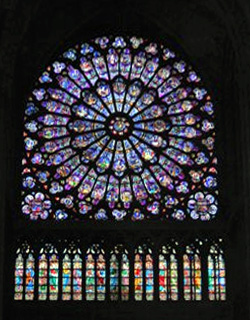
Inside the Notre Dame, the cathedral church of Paris
Then we took a quick peek inside Notre Dame. The cathedral church of Paris, Notre Dame (Our Lady) situated on the Ile de la Cite, is widely considered to be one of the world's finest examples of Gothic architecture. It is believed that Notre Dame occupies a spot where a Gallo-Roman temple once stood, then a Christian basilica, then a Romanesque church before the present cathedral was begun in 1163. It reached its present completed form by about 1345. Notre Dame was pillaged and used as a grain store during the Revolution; here Napoleon seized the crown out of the Pope's hands and, with typical modesty, crowned himself emperor, according to David's painting.
Inside the cathedral, I pointed look out for the memorial plaque to the World War 1 fallen from Australia and the British Empire. The highlights, however, are the Rose windows in the North and South transepts. The North Rose Window, intact since the 13th century, depicts Old Testament figures around the Virgin Mary; the restored South Rose Window shows Christ surrounded by saints and angels. Back in the square, I warned that litter could be a problem. Beware the lunchwrap of Notre Dame.
Onto the Red Bus. Cameras at the ready: the Champs Elysees, perhaps the world's most famous street, runs from the Arc de Triomphe to the Place de La Concorde. The Arc de Triomphe, the world's largest triumphal arch, was commissioned by Napoleon to honour his Grand Armee. He had met his Waterloo long before it was completed.
Then the Eiffel Tower. It was built by the engineer Gustav Eiffel as the focal point of the World's Fair in Paris in 1889, celebrating the centenary of the French Revolution. Sometime during our stay, I must ride to the top again, something I haven't done in years. It provides a bird's eye view of Paris for about 15 Euros. The night-time view I think is even better.
Across the Seine past the base of the tower, then the stately parliament buildings and Napoleon's Tomb. We were soon 'home' in the Latin Quarter on the Left Bank, with its hundreds of budget bistros for lunch.
This afternoon, we went to visit Versailles, the fabled palace of the Sun King Louis XIV who reigned from 1643 to 1715 as an absolute monarch. He built the magnificent palace over 50 years, 25 kilometres south-west of Paris (now suburban).
Millions of French peasants died of starvation while the Bourbon kings lived here in fabulous luxury. Hollywood tells us that the rampaging peasants stormed Versailles and destroyed the magnificent furnishings during the Revolution. Not so.
The Revolutionary Commune sold off the furnishings to various European royals and American millionaires. They are gradually being bought back now, but only 14 of the 300 rooms have been fully restored. At the entrance you will receive a leaflet detailing each of the 20 odd rooms we are allowed to visit, and an audio guide in English. As you will see, Marie Antoinette really let her head go over this place! If Royal bedrooms do little for you, marvel at the Hall of Mirrors, the setting for the signing in 1919 of the Treaty of Versailles, which purported to end World War 1 but which, by its harsh terms, precipitated World War 2. The bus and underground train journey takes about an hour each way.
No visit to Paris, nor indeed any tours of Europe, would be complete without a visit to Sacre Coeur and Montmartre. A short (uphill) walk from the ANVERS Metro station brought us to the funicular (rack railway - one metro ticket) up to the hilltop basilica. The architectural style is called Romano - Byzantine, and it is the only church in this style in the world that we know.
The basilica is only a hundred years old, built with the proceeds of a public appeal after France's disastrous defeat in the Franco-Prussian War. Sacre Coeur was a focal point for the French resistance to the Nazi occupation of Paris in the Second World War.
A 100 metre walk from the basilica brought us to the Place de Tetre and its artists' colony. Here one can buy original paintings of Paris street life or, for $300, can have an absolutely atrocious portrait sketched.
This is where Puccini's opera “La Boheme” (The Bohemians) is set. I don't think anyone had their tiny wallet frozen. The art shops, restaurants and coffee shops around the square and down the numerous alleys leading off the square, kept us busy for hours.
We saw the illuminated Eiffel Tower doing her “on the hour” sparkle as we started down the hill to the Metro home.
PARIS
Saturday
As in Florence and Rome, so in the museums and art galleries of Paris, guided tours are problematic. What is the best way to cover the basics with a good introduction, but not overdo it and cause cultural indigestion? Today we visited what is probably the oldest and possibly the best known of all Europe's art galleries - the Louvre.
The Louvre was the royal palace of the French kings until Versailles was built, but it continued to be used as a city palace until the Revolution. After the Revolution, in 1793, the royal art collection (begun by King Francois I with Leonardo da Vinci's Mona Lisa in the early 16th century) and numbering 2,500 works by the time of the Revolution, was put on public display in the erstwhile royal palace and the Louvre Museum was born.
Napoleon's invasions bore a rich loot of art for the Louvre from the conquered nations. It seems that those great art works of the classical world not in the British Museum in London are here in the Louvre Museum. It now contains over 300,000 works of art and there are over 40 kilometres of corridors. We started with a quick introductory tour to visit the 'Big 3' - the Mona Lisa, the Venus de Milo and the Winged Victory. Then the group was free to start on the remaining 299,997 pieces of art, or repair to the coffee shops. The boutiques and department stores for most I suspect. Again, not a sexist comment.
The non-shopaholics joined me this afternoon for a visit to Monet's Garden. After an early lunch our bus collected us at 1 pm. Yes, I know we are on a rail tour of Europe and supposed to be going through Europe by train, but Giverney is not serviced by rail. We travelled through French countryside leaving Ile de France and crossing into Normandy. The village of Giverney was Monet's home for more than 40 years.
There are two parts to Monet's garden: a flower garden called Clos Normand in front of the house and a Japanese inspired water garden on the other side of the road. The two parts of Monet's garden contrast and complement one another. Claude Monet did not like organized nor constrained gardens. In the Clos Normand he married flowers according to their colours and left them to grow rather freely. In the water garden is the famous Japanese bridge covered with wisterias, other smaller bridges, weeping willows, a bamboo wood and above all the famous nympheas (water lilies).
It is autumn, of course, not Spring so the famous wisteria on the Japanese bridge was not blooming as it is for the Springtime Gardens Tour each year.
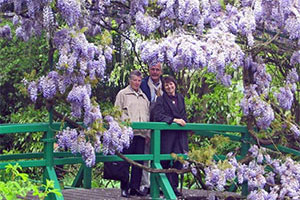
Japanese bridge in Monets' garden
We retraced our steps back to Paris, and decided to end our tour of Europe by rail, as all great train tours of Europe should, by train - the Paris Metro. For our Farewell Dinner I chose the Restaurant at Trocadero with close up views of the floodlit Eiffel Tower.
Small gifts were presented to tour members who had joined the “Noble Order of the Multiple Train Tours of Europe”. Pauline, on her fourth tour, was the winner tonight. Marie won the trivia quiz and took home her Thomas the Tank Engine. There were king words, exchanging of phone numbers and lots of hugs and tears.
HOMEWARD BOUND
Sunday Top
The taxis began arriving early to shuttle to the airport those heading home. Others were staying on in Europe and visiting other places. Some were taking river cruises of Europe.
Only four have chosen the London add-on and we left at midday for Gare du Nord station. Here we began another of the great rail journeys of the world - from Paris to London by Eurostar under the English Channel in two and a half hours. Now that the high speed track is completed on the English side, we cruised at 300kph all the way, except for the actual under Channel sector when the driver slows down to a mere 120kph.
We arrived at London's St Pancras International Station 6 minutes early. More hugs and tears. It was all over.
